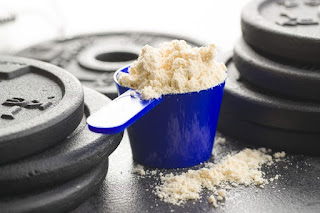How to use creatine?
One of the substances on the list of popular dietary
supplements for athletes is creatine. What is it, what is its action and how to
use it to achieve the best results?
What is creatine?
Creatine is a chemical compound formed from the combination of three amino acids - arginine, glycine and methionine. It occurs in animal organisms from the group of vertebrates, and therefore also in the human body. As much as 98% of the creatine in the human body is stored in the muscles, the remaining 2% is located in the brain, liver, kidneys and testes.
The daily
requirement of an average person weighing 70 kilograms is about 2 grams, which
can be met by introducing an appropriate amount of meat and fish into the diet.
Properties of creatine
The most important properties of creatine include:
- supporting protein synthesis
- stimulating the growth of muscle mass and strength
- stimulating the endurance and speed of the body
- reconstruction of ATP molecules - a substance responsible for storing and supplying energy to muscle cells
- tissue reconstruction
- anabolic properties
- anti-catabolic properties
Due to its properties and the resulting effect on the human
body, creatine supplements are widely used by athletes who want to improve their results and
accelerate the process of gaining muscle mass.
What are the effects of creatine?
Creatine used by strength trainers provides the following
effects:
- Faster muscle growth - taking creatine improves the effectiveness of training, which allows you to accelerate the process of muscle development.
- Increase in strength - by accelerating muscle growth, creatine leads to a proportional increase in strength. The effect of its use is the ability to lift heavier weights leading to improved strength training results.
- Strength increase - the effect of taking dietary supplements for athletes containing creatine is an increase in the endurance of the body and the resulting greater resistance to fatigue. This is because the body is supplied with more energy. The increase in endurance significantly affects the possibility of performing longer and more intense training.
- Accelerating regeneration - creatine has properties supporting muscle recovery after exercise, which in turn allows you to accelerate the regeneration process even after very intense training.
Principles of creatine supplementation
The basic principle in creatine supplementation, which
should be remembered by all people who decide to take it, is the need to
achieve a state of saturation of the body with this substance for a period of
at least a few weeks. Nutritionists and physically active athletes indicate two
methods of taking creatine to achieve this state: two-stage supplementation and
permanent supplementation.
Two-stage supplementation
Two-stage supplementation consists of dividing the creatine
intake cycle into two stages: loading and saturation. During the loading phase,
which is the first stage of supplementation, it is necessary to consume 10 to
30 grams of creatine over a period of 5 to 10 days. In the second stage, the
saturation stage, the creatine dose is reduced to 5 grams and this amount
should be supplied to the body over a period of 4 to 8 weeks.
Permanent supplementation
Constant supplementation, as the name suggests, consists in
consuming a constant dose of creatine on a regular basis. It can be 5 grams a
day or depend on the weight of the person taking it, using the ratio of 1 gram
of the supplement for every 10 kilograms of body weight. This type of
supplementation can be used for a long time without fear of side effects.
The timing of creatine intake does not play any role in the
supplementation process. It has no effect on the effects, which are visible,
however, only after a long period of regular use of supplements containing this
substance.



Comments
Post a Comment